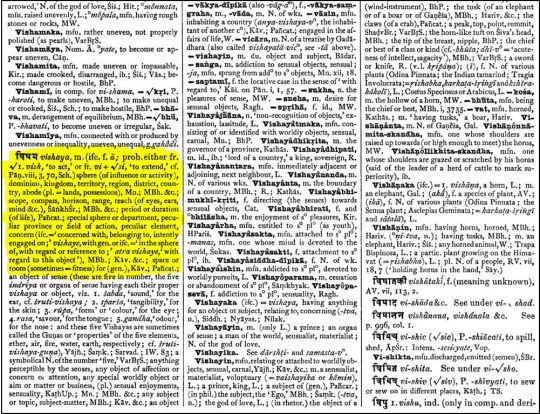Photo
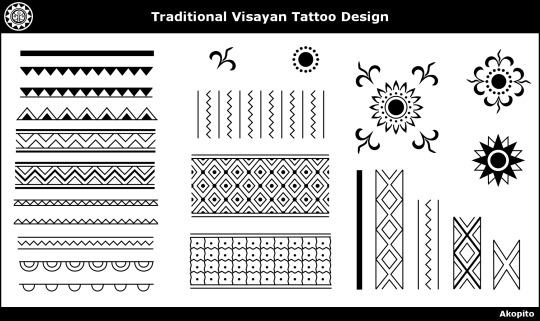

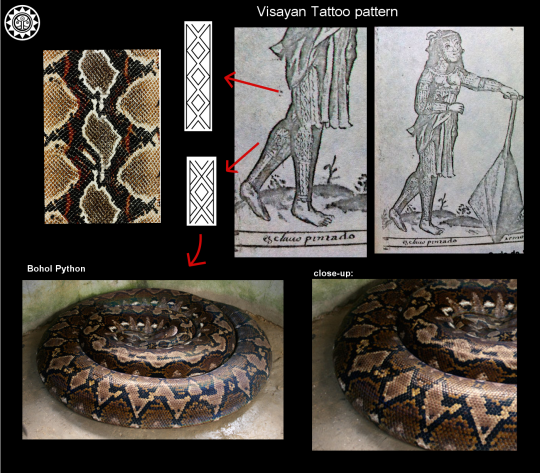
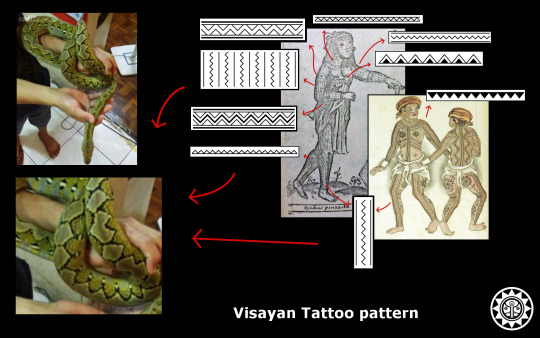

Visayan Tattoo design (The marking of snake and lizard or any other design)
"when they say snake and lizard they actually meant Python and Crocodile :D
http://akopito.weebly.com/1/post/2014/02/visayan-tattoo-design.html
879 notes
·
View notes
Text
Sugbuanon (Cebuano) numbers
1 - Usa
2 - Duha
3 - Tulo
4 - Upat
5 - Lima
6 - Unom
7 - Pito
8 - Walo
9 - Siyam
10 - Napulo / Pulo
20 - kawhaan
30 - Katloan
40 - Kap-atan
50 - Kalim-an
60 - Kanum-an
70 - Kapitoan
80 - Kawaloan
90 - Kasiyaman
100 - Usa ka Gatos
1,000 - Usa ka Libo
10,000 - Laksa
1,000,000 - Usa ka Yukot
1,000,000,000 - Usa ka Wakat
Source: (binisaya.com/content/pagtudlo-sa-matimatika)
65 notes
·
View notes
Text
Tuigan - Sugbuanon (Cebuano) Calendar
Months (Bulan)
January - Ulalong
February - Daghangkahoy
March - Daghangbulan
April - Kiling
May - Himbabuyan
June - Gubay
July - Hidapdapon
August - Lubod-lubod
September - Kangurulsol
October - Bagyo-bagyo
November - Panglot nga Dyutay
December - Panglot nga Dako
Days (Adlaw)
Monday - Tingbukad
Tuesday - Dumason
Wednesday - Dukot-dukot
Thursday - Baylo-baylo
Friday - Danghos
Saturday - Hingot-hingot
Sunday - Ligid-ligid
62 notes
·
View notes
Photo
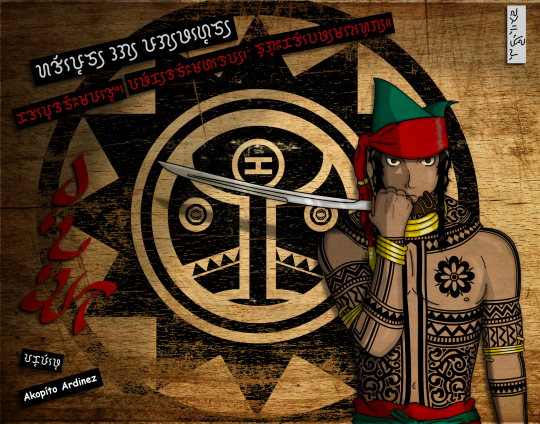
Original post - (http://akopito.deviantart.com/art/El-Guerrero-Pintado-de-Butuan-368443076)
_______________________________________________________
El Guerrero Pintado de Butuan
This is my concept of a Pintado Warrior of Butuan, you probably find the tattoo pattern odd, the tattoo Pattern is inspired by one the early Spanish account description of a Cebuano Tattoo which Pigafetta describe as Fiery or wavy pattern tattoo as he mentioned in his journal when Magellan and his crew visited the island of Cebu. mixing it with the generic tattoo design which you can find it on one of the Bisaya illustration in the 1500s Boxer manuscript and Alcina’s depiction of a Bisaya tattooed warrior which they described as Bold line and Zigzag pattern.
The Chest tattoo is a Sampaguita design tattoo (it’s not actually a sun tattoo, its actually a flower tattoo which is very similar to the Bornean Tattoo)
The Sword is an Ilonggo blade which is the “Ginunting” the hilt design which mimics a Beast head is inspired by one of the Ginunting images which you can find it on “Filipino History & weapon” facebook page,
Font used:
Bisaya - http://fav.me/d5qrjr2
Kulitan - http://fav.me/d6384i6
Visit me on:
Homepage - http://akopito.weebly.com/
Tumblr - http://akopito.tumblr.com/
Padáyon sa inyong gibátî
43 notes
·
View notes
Photo

The vision of Fransico Dagohoy
by Quennie Ann Palafox
Located in the heart of Visayas, Bohol became the battle ground for Filipinos who rose in arms against the Spaniards in pursuit for absolute freedom. The most prominent of which was Francisco Dagohoy- the ringleader of the uprising that lasted for 85 years, the longest in history of the Philippines. This personal vengeance against the persons turned into a serious and major uprising that will endure for many years even after the death of Dagohoy. This movement aimed to make Bohol once more a land of free men, can be considered as one of the earliest victory of Filipinos over the Spaniards as the island fell into the hands of the natives.
Bohol, a disk-shaped island, the size very much similar to Cebu, was the place where the vessel Concepcion was abandoned and burned after Magellan’s death in Mactan in 1521. In 1565, Miguel Lopez de Legazpi entered into a blood compact with Rajah Sikatuna of Bohol to establish friendship with the native ruler. Soon after the conquest of the archipelago, religious jurisdiction over the island was given to the Society of Jesus.
In 1744, the district of Inabangan in the northwest coast of the island was put under the auspice of Father Morales. He sent out a native constable named Dagohoy to arrest a renegade indio, but Dagohoy himself was killed instead. Francisco, Dagohoy’s brother, brought the corpse back to the village for burial in consecrated ground, according to the Catholic practice. Probably irked that the man had failed in his mission, Father Morales refused permission for a Catholic burial and Dagohoy’s cadaver lay rotting for three days. Francisco infuriated at the unsympathetic and treatment by the parish priest, he cursed the Jesuit and sought for revenge by persuading the natives of the district to unite with him in overthrowing the Spaniards. Some 3, 000 men and their families abandoned their homes in the lowland and trekked to the inaccessible mountainous interior where they built a fortification.
In a remote region in the mountains between Inabangan and Talibon, Dagohoy established his headquarters and proclaimed the independence of Bohol. Dagohoy and his men sallied out in lightning raids on the lowland towns, assaulting the local Spanish garrisons, looting the churches, and slaughtering Spaniards, particularly the Jesuit priests. On January 24, 1746 one of Dagohoy’s bold warriors killed Father Giuseppe Lamberti, an Italian Jesuit and parish priest of Jagna.
The Spanish authorities were worried by the remarkable successes of Dagohoy. In 1747 Bishop Juan de Arrechedera of Manila, then acting governor-general, dispatched a Spanish expedition to Bohol under the command of Don Pedro Lechuga, Dagohoy resisted this expedition and forced it to withdraw to Zamboanga. Later Bishop Miguel Lino de Espeleta of Cebu, who became acting archbishop and governor-general, tried to pacify the rebels. But Dagohoy refused to listen to him.
The rebellion assumed dangerous proportions. Numerous recruits, disgusted at the string of injustices and tyranny committed by the Spaniards, joined Dagohoy. Except for a dozen coastal towns and villages protected by armed Spaniards and native police, the rebels controlled the island.
The bishop, a creole, tried to defuse the situation in Bohol by offering to send secular priests to administer the parishes. The insurgents, however, remained firm in their rebellion. They would not accept the presence of civilian official. Evidently, Dagohoy and his followers were not against the Catholic religion, but resolutely refused to come again under the political domination of Spain.
The Recollects replaced the Jesuits, and Father Pedro de Santa Barbarra, who was stationed in Baclayon, ascended the mountains to interview Dagohoy. He was welcomed and well treated, but Dagohoy courteously refused to give up Bohol’s independence. Supplementing the peace efforts of the Recollects, Governor-General Jose Raon offered amnesty and pardon to Dagohoy and his followers if they would lay down their arms. Dagohoy spurned his offer, saying that his people were enjoying the good life of a free people.
From 1744 to August 31, 1829, a long period of 85 years, the Boholanos successfully maintained their independence and preserved it with fierce and courage and flaming patriotism. It seemed probable that Dagohoy died before the year 1829 in his mountain kingdom either of old age or sickness. His followers, imbued by his indomitable courage and fearless heroism carried on the fight for independence. Twenty Spanish governor-generals, from Gaspar de la Torre (1739-1745) to Mariano Ricafort (1825-1830), failed to suppress the libertarian struggle.
The year of Dagohoy’s death is not mentioned in any history books, but since the revolt continued, it meant three generations of Boholanos were enjoying their liberty. Through the efforts of Fray Pedro de Santa Barbara, a Recollect friar, troops were withdrawn in 1770 from most of the island’s stations, and a general amnesty was proclaimed. Few rebels presented themselves under proclamation. The raids of the loyalist continued.
Punitive expeditions were mounted against them, but these failed until May 1827, when acting Governor-General Mariano Ricafort, appalled the poorly-armed islanders could defy Spanish might, sent to Bohol a powerful army of 1, 100 Spaniards from the Manila and Cebu garrisons, with a contingent of 6, 024 natives from Bohol and Cebu. This task force was not completely successful, and the following summer, in April of 1828, he dispatched another military host armed with light artillery to pulverize the mountain forts of the rebels in Inabangan and Talibon. This time Ricafort’s troops were successful. Thus terminated the longest revolt in Philippine history and, next to the revolution of 1896, the most successful in eroding Spanish sovereignty over the archipelago. Missing Dagohoy’s excellent leadership, the Boholanos made their last stand in the mountain of Boasa.
During the 85 years of Bohol’s independence, the patriotic Boholanos lived as free and sovereign people. They did not render forced labor nor pay tribute. They suffered neither racial discrimination nor social humiliation from the hands of the Spaniards. Dagohoy was able to maintain a government. His rule was firm and just. He was obeyed and respected by his people. Governing like the datus of the pre-Spanish era, he was the chief executive, the supreme judge, and the military generalissimo. He was assisted by the old men in peace affairs and by the military captains in war matters.
http://www.nhcp.gov.ph/index.php?option=com_content&task=view&id=346
#dagohoy#visayas#bohol#cebu#tamblot#bisdak#bisdak nation#bisaya#visayan#revolt#rebellion#boholanos#fransisco
18 notes
·
View notes
Photo
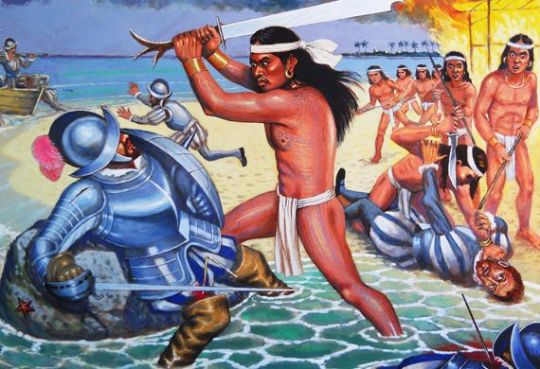

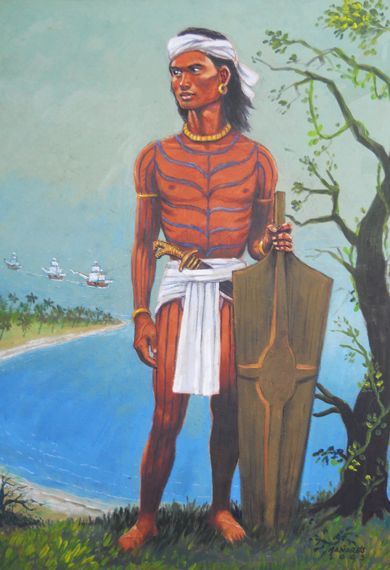
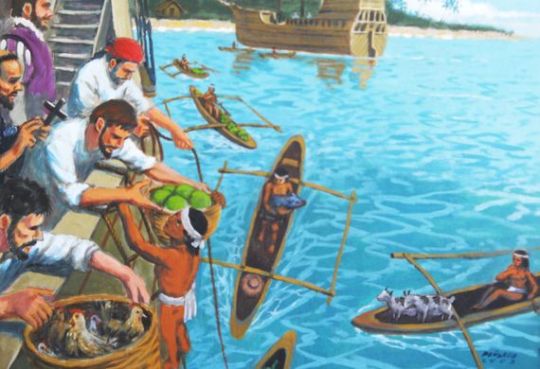
Paintings by well known Filipino painter, Manuel Pañares.
Part 1
Top: The Historic Battle of Mactan (April 27, 1521) led by one of the first known hero’s of what is now known as the Philippines, Datu Lapu-Lapu. The painting depicts the battle where in the end Portuguese explorer Ferdinand Magellan is slained and killed by Datu Lapu-Lapu and his warriors,where they stabbed him in his arm with a spear and in the leg with a kampilan before he was finished off by Datu Lapu-Lapu’s warriors. This event marks the first, of many fights and rebellions against the colonization of the Spaniards and eventually the Americans.
Middle Left: Painting of Rajah Humabon (also known as Rajah Hamabar), the ruler of Sugbo (Cebu) and the first converted Christian in the Philippines along with his wife, the Queen Humamai, and 800 other locals who were all baptized on April 14, 1521. Humabon was given the name Carlos and his wife Juana. Magellan then gave Humabon an image of the suffering Jesus (Ecce Home) and his wife an image of the child Jesus (Santo Niño.) He also erected a large wooden cross (Magellan’s Cross) at the baptismal site. According to Magellan’s chronicler Antonio Pigafetta, ”Rahah Humabon was fat and short and tattooed with fire in various designs. He wore only a cotton cloth before his privates and a scarf embroidered with needle about his head. A necklace of great value hanging from his neck and two large gold earrings fastened in ears set round with precious gems.” Today, a park which honors the Rajah who was considered the ”wisest and bravest man in the island” during his time can be seen in downtown Cebu. The name of the place is Plaza Hamabar. The plaza stands as a symbol of Humabon’s mark. A legacy which remains until this very day.
Middle Right: Painting depicting a Pintado (Visayan) warrior. At the arrival of the Spaniards they originally called the people of the Visaya’s, Pintado’s (painted ones), and called the islands, La islas de Los Pintados, “The Islands of the Painted Ones”, as the people, men, women, and children who were old enough, all were “painted” with elobrate markings throughout their bodies. The Spaniards not knowing the art of tattooing, or batuk/butok in the Visaya’s, thought it was permanent paint and later learned how the natives put on the “permanent paint” and why. The designs on men were more bolder while on the women lines were more finer and delicate like the threads in weaving. Men who had facial tattoo’s were known as the greatest and strongest of warriors and were often more feared. Besides the tattoo’s the Visayan’s had throughout the islands, many were dressed in gold ornaments, from the upper class to even the slaves.
Bottom: Barter Trading at the Port of Sugbu(Cebu). Many of our earlier ancestors, mainly those who lived on the coasts, were known traders and were known and recorded to be a part of the immense trading routes in maritime Asia, trading with those from China, Japan, Borneo, Java, & Vietnam to name a few.
773 notes
·
View notes
Photo
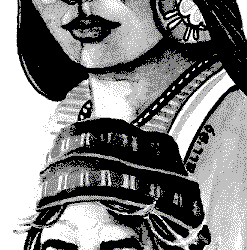
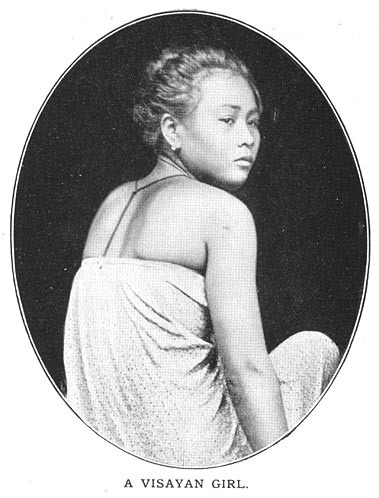
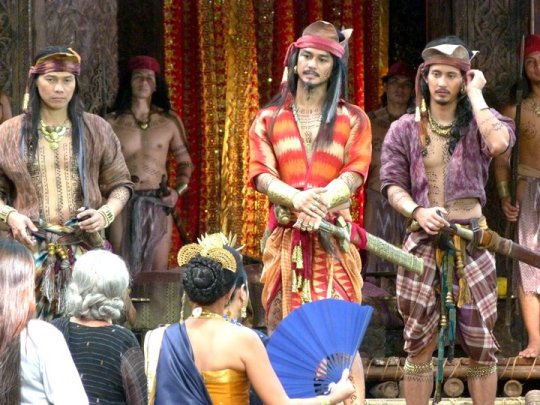
16th Century Hair and Hair Care in Pre-Colonial Philippines
Article written by Ligaya for Pinoy-Culture
Hairstyles change from generation to generation. Today the typical hairstyles among Filipino’s is a buzzcut for men, or just keeping it short in general, and having long hair among women while coloring and dying the hair is pretty much a thing among Filipina’s both young and old. Today many people see long hair among men as strange, or only for those who are in a rock band *cough* my Tatay *cough*. However long hair among our ancestors, both men and women, was both a cultural and spiritual thing.
In the 15th-16th Centuries, our ancestors were very prideful of their hair. In the 1520’s, the Visayans in Homonhon, an island in the province of present day Eastern Samar, were seen and recorded to have hair down to their waists. In Surigao, that is located on the northeastern tip of Mindanao, men tended to pull their hair back into a knot at the nape of their neck. While in Butuan, another well known region in northeastern Mindanao, a King was known to wear his hair at shoulder length. Others would gather their hair and wrap it in a knot with a headcloth or turban known as a putong.
Others such as the Tagalogs however did choose to cut their hair, mainly from the influences of Islam considering at the time of the arrival of the Spaniards the Tagalog kingdoms Maynila also known as Kota Seludong and Tondo were already Islamized kingdoms with a mix of indigenous animistic and Hindu-Buddhist beliefs. In the Visaya’s there was a saying, Inalotan ka! This was actually more of a curse back then, especially toward a Tagalog, who tended to cut their hair short. Alot, was also a term the Visayans called the Tagalogs who had short hair, which means shorn, according to one of the early Visayan dictionaries by Fr. Alonso de Mentrida in his 1637 dictionary, Bocabulario de la lengua Bisaya-Hiligueyna y Haria de las islas de Panay y Sugbu y para demas las islas.
In the Visaya’s, cutting one’s hair was a symbol of punishment or mourning. It was only cut when they were being punished for a crime as a sort of shame, or someone, a close relative for example, died. In this case both the mourner and the person who died, their hair would be cut as a symbol of mourning.
During this time, the surviving relative would cut off their hair, especially the women. It was a sign of deep affection for the dead husband, fathers, etc. With the locks of their cut hair, they either placed it in the casket of their dead loved ones or they kept it as a memoir. If they choose to keep it, from time to time they took it out and held it in their hands as they wept in memory of the dead person.
Another time where one would cut their hair is if they were expected to go on a very long journey. Known as balata, this was the cutting of hair and leaving it in t heir house until they returned from their long voyage.
Our ancestors took care of their hair very vigorously, to the point they saw their hair as an ornament to be taken care of. Both men and women were known to have flowers in their hair, perfumes from the oils of certain flowers and plants, musk of the civet, ambergris, as well as coating their hair with sesame seed and coconut oils to groom it. Like mentioned above, our ancestors were known to put flowers and other ornaments in their hair as well as perfumes and oils such as sesame seed oil which were believed to encourage luxuriant growth. A perfumed ointment called Bulat, as well as flowers or sesame seed oil would be worked into the hair for fragrance. Datus and warriors preferred the bolder scent of ambergris, civet or musk excretions. Even today, the use of these oils and other indigenous hair care remedies is still used today like gugo, which is a vine that is crushed and dried, then soaked in water to extract the juices to be used as shampoo. Others are Sabila or aloe vera for hair growth and of course the well known and very loved coconut oil that most people growing up in the Philippines probably had their mothers or grandmothers teach them how to extract the oil and use it such as in the case of everyone in my family.
In the records by Antonio de Morga in his 1609 Sucesesos de las Islas Filipinas, he noted that men and women, especially the chiefs, were very clean and neat in their persons and clothing. They dressed their hair carefully, and regard it as being more ornamental when it is very black. He already recorded down the use of gugo, which was was also used in pre-colonial times. In his passage he mentions how the people wash their hair with water that has been boiled with the bark of the vines of the gugo (which is also scientifically known as Entada purseta), that grows in most of the provinces of the Philippines. This remedy is also used in the use of washing clothes and precipitate the gold in the sand of rivers.
Women tended to grow out their hair, at times to the point of reaching ankle length. From this long length of hair they gathered it into a type of chignon, or pusod in Tagalog, as large as the head itself with curls over the forehead. They also added in additional artificial hair extensions (or switches as they were called back in the day) that they called Panta or talabhok which were their crowning glory. They also had combs or suklay made of wood or ivory with intricate carvings to groom themselves.
During this time it was a great offense for a man to touch a woman’s hair without her permission if they were not a relative or lover, to the point it was seen as a crime in society. However, women were known to touch another women’s hair during fights where they would pull each others hair in aggression. This was a very common thing to where the Visayans had a word for this fight of a women pulling on another’s hair, especially the talabhok, that was known as sampolong.
It wasn’t until the arrival of the Spaniards and in later years of colonization did our ancestors start to cut their hair, especially the men. In Alcina’s and the church’s eye’s this act of cutting their hair was an act of “taming their ancient ferocity with the gentleness of the Gospel”. This was because long hair, mainly on the men, was thought to be “uncivilized”, and “barbaric”, and the cutting of their hair to follow the examples of the short hairstyles of the Spaniards was an act of God and of bringing the people out of their “savage ways”.
An example of this in more recent times is during the early 1970’s when the late President Ferdinand Marcos ordered all Filipino men to cut their shoulder length hair during the Martial Law. This was, like the Spaniards before him, was a part “taming their revolutionary spirit.”
Besides the hair on the head, they also groomed facial hair. Not many sported beards, as most removed facial hair with a pair of clam shells that acted like tweezers. In the Visaya’s, both men and women also tended to pluck their eyebrows and form it into thin arcs resembling the crescent moon. For the Tagalogs, men did grow mustaches, called misay, but like many others in the archipelago they tended to get rid of beards, known as gumi.
Sources:
- Barangay: 16th Century Philippine Culture and Society by William Henry Scott.
- Relation of the Western Islands called Filipinas. Diego de Artieda 1573
- Historia de las islas e indios de bisaya (1668) Volume III by Francisco Ignacio Alcina.
- Antonio de Morga in his 1609 Sucesesos de las Islas Filipinas.
- Fr. Alonso de Mentrida in his 1637 dictionary, Bocabulario de la lengua Bisaya-Hiligueyna y Haria de las islas de Panay y Sugbu y para demas las islas.
620 notes
·
View notes
Photo

A Philippine karakoa. This illustration is found in Scott’s most popular book Barangay (1994).
“But the most celebrated Visayan vessel was the warship called karakoa — a sleek, double-ended cruiser with an elevated fighting deck amidships, and catwalks mounted on the outrigger supports to seat as many as six banks of paddlers. They displayed tall staffs of brilliant plumage fore and aft as a sign of victory, called sombol on the prow, tongol on the stern.” — William Henry Scott, Barangay
177 notes
·
View notes
Link
Centuries ago a tribe in the mountains of Tapaz, in the then town of Capiz had a rather strange practice that bordered on the mystical; they kept the most beautiful female offspring in their families hidden from sunlight until the day of her betrothal. For the entire time that she remained in the darkness of a room in their hut, food and drink was brought to her and the tribes-folk believed that this gave her the magical powers of a babaylan. Whenever the farms were being readied for planting in the uplands, the young sunlight-deprived lass is taken out to dance and chant in the fields under the moonlight, to ensure an abundant harvest. As would be expected, Binukot women are very good epic chanters having the longest recorded epic in the country of over thirty hours. In no time, the entire tribe became known for this practice of hiding their beautiful females from sunlight, locally known as ‘bukot’, and hence, the word ‘binukot’ which means ‘to hide’ or to ‘keep’…. read more…
similar article: More than a princess: The Binukot of western Visayas
10 notes
·
View notes
Text
Hinilawod
Hinilawod is an epic poem written by the early inhabitants of a place called Sulod in central Panay Visayas, Philippines. The Term “Hinilawod” means Tales From The Mouth of The Halawod River”.

THE STORY:
When the goddess of the eastern sky Alunsina (also known as Laun Sina, “The Unmarried One”) reached maidenhood, the king of the gods, Kaptan, decreed that she should marry. All the unmarried gods of the different domains of the universe tried to win her hand to no avail. She chose to marry a mortal, Datu Paubari, the mighty ruler of Halawod.
Read More
88 notes
·
View notes
Link
There is a resurgence of interest on Pre-Hispanic Philippine syllabaries (baybayin or surat). This interest is very much welcomed. Anything that is older than Philippines 1521 is something worth exploring and analyzing. read more…
10 notes
·
View notes
Photo
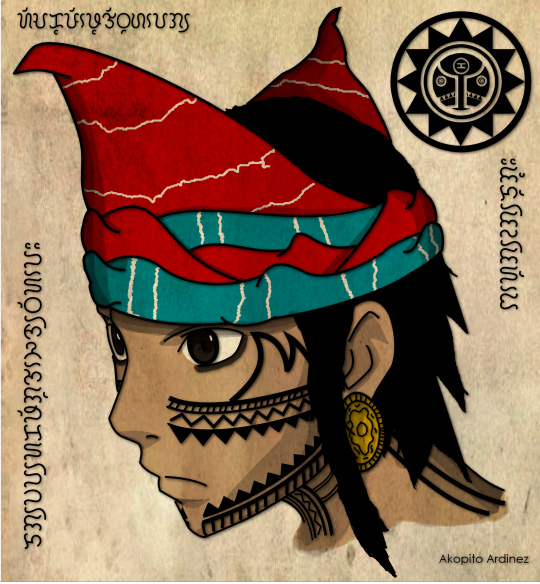
http://akopito.deviantart.com/art/The-Face-of-Feudal-Bisaya-347601352
Dagway sa Katigulangan Bisaya
(The Face of feudal Visayan)
The Face tattoo is only restricted for those Elite Warriors of Feudal Visayas, according to Book Barangay sixteenth-century philippine culture and society by William Henry Scott, ‘Bangut’ is what they called the face-tattoo, other Visayan language probably? had a different term for the face-tattoo, the design which mimics a crocodiles jaw is called ‘langi’ it also mentioned about a beak design, In Pigafettas journal he mentioned that Rajah Humanbon of Cebu had a flame-like design tattoo on his face.
“The Red head-gear or Pudong/Purong is what they called “Magalong”, it signifies the most valiant warrior in Feudal Visayas.”
64 notes
·
View notes
Link
Spanish accounts are unanimous in saying that Filipinos did not use their alphabet for literary compositions or records keeping: the Boxer Codex states unambiguously that they used their script only for letters and messages. Visayan literature therefore was oral literature, and as such, was not...
83 notes
·
View notes
Link
Henry Funtecha, Ph.D.
When the Spaniards arrived in the Visayas in the 1520s (Magellan expedition) and the 1560s (Legaspi expedition), they widely used the term “Pintados” to refer to the inhabitants. Pintados means the “painted ones” due to the fact that the Bisayans were fond of decorating their bodies with tattoos, both men and women. read more...
11 notes
·
View notes
Link
by Vicente Calibo de Jesus
The first Philippine words ever recorded were Bisayan, consisting of Cebuano and a number of Butuanon words. The 160-word vocabulary was compiled by Antonio Pigafetta, the Vicentine diarist who wrote the most comprehensive account of the first circumnavigation of the globe. read more...
5 notes
·
View notes
